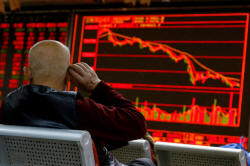Stocks clamber up from 4-week lows, dollar eases from 10-week high
 Send a link to a friend
Send a link to a friend
 [June 21, 2021] By
Ritvik Carvalho [June 21, 2021] By
Ritvik Carvalho
LONDON (Reuters) - Global stocks recovered
some losses after hitting a four-week low on Monday as investors
continued to digest last week's surprise hawkish shift by the U.S.
Federal Reserve, while the dollar stood just below a 10-week high.
Shares of banks, energy firms and other companies that tend to be
sensitive to the economy's fluctuations have fallen sharply since the
Fed's meeting on Wednesday, when the central bank caught investors off
guard by anticipating two quarter-percentage-point rate increases in
2023.
Stocks in Asia took their cue from Wall Street's falls on Friday but
European shares bucked the trend, with the pan-European STOXX 600 index
up 0.2% by afternoon trade in London. [.EU]
U.S. stock futures also moved firmly into positive territory, suggesting
gains at the open on Wall Street later in the day. S&P 500 E-mini
futures were up [.N]

"The interesting part about this correction is that it was lagged, so it
took a while for the market to sort through the news," said Sebastien
Galy, senior macro strategist at Nordea Asset Management.
"The situation in reality is actually pretty good - the Fed is
stabilizing inflation...Cyclical sectors may have overshot the market in
the short term and so you may have a bit of pressure on the sector."
Britain's FTSE 100 was down 0.1%, France's CAC 40 index gained 0.3% and
Spain's IBEX 35 fell 0.3%. Germany's DAX was up nearly half a percent,
while Italy's FTSE MIB index rose 0.2%.
MSCI's All Country World Index, which tracks shares across 49 countries,
was down 0.2%, trimming some losses after hitting its lowest since May
24.
Benchmark 10-year U.S. Treasury yields recovered to 1.4414% after
falling to their lowest since Feb. 24 at 1.3540%.
The yield curve - measured by the spread between two- and 30-year yields
- earlier hit its flattest since late January, and as investors brought
forward rate hike expectations while lowering the longer-term outlook
for growth and inflation.
The U.S. dollar index hovered just below the 10-week high of 92.408
touched on Friday, following its biggest weekly advance in more than a
year.
"Last week's dollar rally is a combination of expectations and
positioning (sold dollars), a concern that the Fed is 'behind the curve'
(and therefore must do more and earlier than expected), and that stock
markets have started to lose ground which makes the dollar strengthen as
the most defensive currency," Filip Carlsson, junior quantitative
strategist at SEB, said in a morning note.
"We still see this as a correction and not the beginning of a new
trend."
St. Louis Fed President James Bullard further fuelled the sell-off on
Friday by saying the shift toward faster policy tightening was a
"natural" response to economic growth and particularly inflation moving
quicker than anticipated as the country reopens from the coronavirus
pandemic.
[to top of second column] |

An investor sits in
front of a board showing stock information at a brokerage office in
Beijing, China, December 7, 2018. REUTERS/Thomas Peter/File Photo

"The Fed's pivot to begin the tightening discussion caught most by surprise, but
markets began discounting this inevitable process months ago in our view,"
Morgan Stanley analysts wrote in a report.
"It's exactly what the mid-cycle transition is all about, and fits nicely with
our narrative for choppier equity markets and a 10-20% correction for the
broader indices this year."
Earlier in Asia, Japan's Nikkei led declines with a 3.6% drop and dipped below
28,000 for the first time in a month, while MSCI's broadest index of
Asia-Pacific shares outside Japan fell 1.4%. Chinese blue chips lost 0.7%.
Several Fed officials have speaking duties this week, including Chair Jerome
Powell, who testifies before Congress on Tuesday. European Central Bank
President Christine Lagarde speaks before the European Parliament on Monday.
The euro traded above its lowest against the dollar since April 6 at $1.1896 on
Monday, dropping from as high as $1.21457 last Tuesday.
Sterling recovered some ground, to trade 0.6% higher at $1.3880 after sliding to
its lowest since April 16 on Friday. [GBP/]
Commodity-linked currencies have also suffered, with the Australian dollar
hovering above a six-month low at $0.7495.
A stronger greenback has pressured cryptocurrencies too, with bitcoin falling
10% to around $31,930, while smaller rival ether lost 15% to around $1,903.
In commodities, gold rebounded 1.1% to $1,783 an ounce on Monday, looking to
snap a six-day losing streak, but remained near the lowest since early May.
Three-month copper on the London Metal Exchange fell to its lowest since April
15, following an 8.6% drop last week, the biggest weekly fall since March 2020.
Crude oil rose for a second day, underpinned by strong demand during the summer
driving season and a pause in talks to revive the Iran nuclear deal that could
indicate a delay in resumption of supplies from the OPEC producer.

Brent crude futures rose 0.1% to $73.56 a barrel, while U.S. West Texas
Intermediate (WTI) crude rose 0.1% to $71.74 a barrel.
(Reporting by Ritvik Carvalho; Additional reporting by Kevin Buckland in Tokyo;
Editing by Catherine Evans and Peter Graff)
[© 2021 Thomson Reuters. All rights
reserved.] Copyright 2021 Reuters. All rights reserved. This material may not be published,
broadcast, rewritten or redistributed.
Thompson Reuters is solely responsible for this content. |